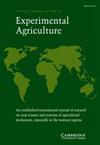Yam-Minisett技术处理农药对环境和经济的影响
IF 1.9
4区 农林科学
Q1 Agricultural and Biological Sciences
引用次数: 1
摘要
摘要白薯(Dioscorea rotundata)在许多国家是一种重要的块茎作物,但在西非尤其如此,因为当地市场上出售过量的产量,白薯既是主食也是经济作物。但是,对农民来说,优质种植材料的可用性仍然是一个重要的制约因素,其中最显著的是种子红薯。已经开发了一些技术来帮助解决这一限制,方法是将块茎切成小块(迷你块茎),通过种子敷料灰尘或杀虫剂“蘸酱”对其进行处理,并种植所需大小和质量的种子。但是,尽管对农学和农民采用这些技术的研究很多,但对其经济表现的研究却很少。事实上,到目前为止,还没有研究将处理sett与不处理sett的经济性能进行比较,也没有对处理sett对环境的影响进行任何分析。本文报告了一项旨在解决这两个知识差距的研究结果,该研究基于尼日利亚中部地带4年(2013-2016年)建立的一系列农民管理的种薯地的结果。结果表明,与未经处理的相比,经处理的sett的收入和毛利率更高,尽管后者仍然表现相对较好。使用现场使用环境影响系数(EIQ),通常推荐的农药沉降处理方法估计具有低至中等的环境影响,需要进一步研究农药使用量可以减少到多大程度才能仍然有效并将任何环境影响降至最低。本文章由计算机程序翻译,如有差异,请以英文原文为准。
Environmental and economic impacts of pesticide treatment in the Yam Minisett Technique
Abstract White yam (Dioscorea rotundata) is an important tuber crop in a number of countries, but especially in West Africa where it serves as a food staple as well as a cash crop as excess production is sold in local markets. But the availability of quality planting material, most notably seed yams, for yam production remains an important constraint for farmers. Techniques have been developed to help address this limitation by cutting yam tubers into pieces (minisetts), treating them with the pesticide either via a seed dressing dust or pesticide ‘dips’ and planting to grow seed yams of the required size and quality. But while there have been many studies on the agronomy and adoption by farmers of these techniques, there have been fewer studies on their economic performance. Indeed, to date there have been no studies that compare the economic performance of treating setts compared to leaving them untreated, and neither has there been any analysis of the environmental impact of treating setts. This paper reports the results of a study designed to address these two gaps in knowledge and is based upon results from a series of farmer-managed seed yam plots established in the middle belt of Nigeria over 4 years (2013–2016). Results suggest that revenue and gross margin were higher for treated versus untreated setts although the latter still performed relatively well. Using the Field Use Environmental Impact Quotient (EIQ), the commonly recommended pesticide sett treatments were estimated to have a low-to-moderate environmental impact, and further research is needed to see how far pesticide use can be reduced to still be effective and minimise any environmental impact.
求助全文
通过发布文献求助,成功后即可免费获取论文全文。
去求助
来源期刊

Experimental Agriculture
农林科学-农艺学
CiteScore
2.50
自引率
6.20%
发文量
29
审稿时长
24 months
期刊介绍:
With a focus on the tropical and sub-tropical regions of the world, Experimental Agriculture publishes the results of original research on field, plantation and herbage crops grown for food or feed, or for industrial purposes, and on farming systems, including livestock and people. It reports experimental work designed to explain how crops respond to the environment in biological and physical terms, and on the social and economic issues that may influence the uptake of the results of research by policy makers and farmers, including the role of institutions and partnerships in delivering impact. The journal also publishes accounts and critical discussions of new quantitative and qualitative methods in agricultural and ecosystems research, and of contemporary issues arising in countries where agricultural production needs to develop rapidly. There is a regular book review section and occasional, often invited, reviews of research.
 求助内容:
求助内容: 应助结果提醒方式:
应助结果提醒方式:


